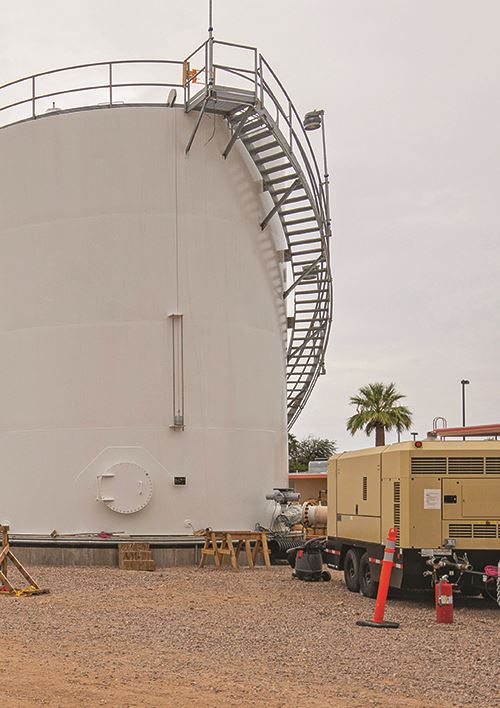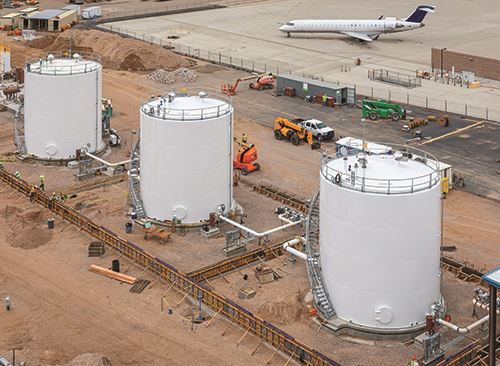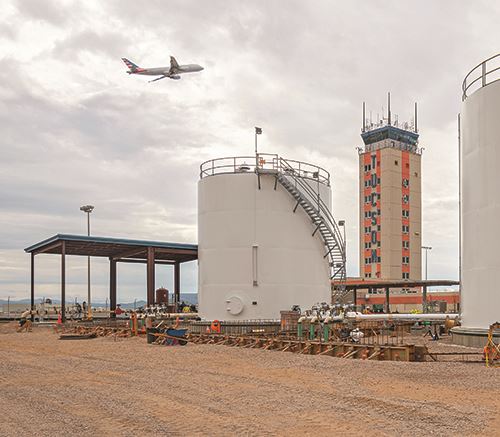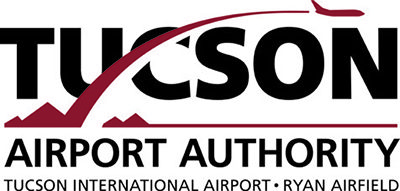When it’s time to update or replace an aging jet fuel facility, financing can be a big challenge. At Tucson International Airport (TUS), the local airline consortium worked with airport officials and an outside engineering consulting firm to find a creative way to ensure a steady fuel supply for all airport users.
When it’s time to update or replace an aging jet fuel facility, financing can be a big challenge. At Tucson International Airport (TUS), the local airline consortium worked with airport officials and an outside engineering consulting firm to find a creative way to ensure a steady fuel supply for all airport users.
 The need for a new fuel facility at TUS became evident as early as 2014. “Our old fuel station, which dates back to the 1970s, was nearing the end of its useful life and becoming expensive to maintain,” explains Danette Bewley, president and chief executive officer of the Tucson Airport Authority. “We knew there were more efficient ways to manage it, so we started discussions with the airlines, which created the local fuel consortium (Tucson Fuel Facilities LLC) to take over its operation.”
The need for a new fuel facility at TUS became evident as early as 2014. “Our old fuel station, which dates back to the 1970s, was nearing the end of its useful life and becoming expensive to maintain,” explains Danette Bewley, president and chief executive officer of the Tucson Airport Authority. “We knew there were more efficient ways to manage it, so we started discussions with the airlines, which created the local fuel consortium (Tucson Fuel Facilities LLC) to take over its operation.”
That transition went smoothly, she adds, and discussions quickly turned to improving the outdated fuel facility to meet future needs. “We were all on the same page,” Bewley reports.
|
Project: New Fuel Facility Location: Tucson (AZ) Int’l Airport Key Components: Trio of 168,000-gallon above-ground tanks connecting to existing hydrant system; new operations building with digital & electronic systems to measure incoming & outgoing fuel
Cost: $28.8 million Timeline: Cost analysis performed in 2016; permits approved in early 2019; construction late 2020 to early 2022 Local Fuel Consortium: Tucson Fuel Facilities LLC Airline Members: Alaska; American; Avelo; Delta; FedEx; SkyWest; Southwest; United Fuel Facility Operations/Fuel Management: Swissport Facility Lease: Sept. 1, 2019-June 30, 2051 Est. Annual Lease Rate: $.50/sq. ft. per year 2019 Fuel Distribution: 27,258,689 gallons 2019 Consortium Aircraft Operations: 21,378 General Contractor: Burns & McDonnell Mechanical Subcontractor: Ref-Chem LP
Electrical Subcontractor: Triad Civil Subcontractor: L. Keely Construction Tank Subcontractor: Pittsburg Tank & Tower |
After Tucson Fuel Facilities took over operations in 2014, one of the first things it did was hire Burns & McDonnell to evaluate the facility and determine what needed to be upgraded to meet current and future needs.
Cost Analysis
The engineering consulting firm began a detailed analysis of the existing fuel station in 2016. “The electrical system was 40 years old, and in poor shape,” states Grant Smith, director of the Commercial Fueling and Ramp Services Aviation Group for Burns & McDonnell. “Mechanical parts were at least 30 years old. The underground storage tanks were single-walled; federal regulations for new installations now require fuel tanks to be double-walled.”

In the end, the team estimated it would cost between $15 million and $20 million to upgrade the existing single-walled underground tank system. The cost for a new system with above-ground storage tanks and a new operations building was approximately $25 million.
Not surprisingly, the relatively small price difference between the two options made the consortium lean toward building new. However, spending $25 million would be a challenge, explains Mark Bourdeau, global fuel procurement and operations manager for Delta Air Lines and consortium chair at the time. “All of our members knew the old fuel facility was not feasible long-term, and that it had to be replaced,” says Bourdeau. “We were having more and more mechanical problems with it. As a result, we asked Burns & McDonnell to extend our agreement with them and help us come up with a solution on financing.”
One of the keys to accomplishing this was an agreement about when the engineering consultant firm would get paid. “We did charge [the consortium] upfront for the initial cost analysis work,” explains Smith. “However, we agreed to delay getting most of our fee until all the financing was in place, and construction actually began.”
Details regarding the exact scope of the project could not be determined until the design process was further along. Instead of charging the fuel consortium its regular fee for that work, Burns & McDonnell agreed to cover those upfront costs. “After a contract with Tucson Fuel Facilities was finalized, our team went through the process of developing a capital budget for the new facility through internal design work and cost estimating,” Smith says. “We also agreed to supervise the design, all construction phases and operations training. We are responsible for delivery and the final product, and all this required us to work closely with airport officials from start to finish. They were very helpful in helping us get permits approved from the fire department, environmental agencies and other local officials.”

Before any of this was done, the consortium’s current lease with the airport had to be extended, Smith adds. A 30-year term provided security for both the airport and its lending institutions. The Burns & McDonnell team worked closely with airport and consortium officials during the lease revision process.
Working on the new lease was a complicated process that took months. “Our attorneys and the Tucson Fuel Facilities attorneys had discussions on many provisions,” says Bewley. “The final lease amount will depend on the final footprint of the fuel facility once it opens.”
After the new lease was signed, the fuel consortium was then able to shop for financing. This process was expedited because the airlines based at TUS had already established themselves with insurance companies, banks and other potential lenders. “The lender we chose also had a relationship with Tucson airport officials over the years,” says Bourdeau. “As a result, obtaining financing was not really an issue. We got a good interest rate to ease the financial obligations of our organization.”
In addition, the eight airlines that belong to the fuel consortium will not have to pay extra fees. Expenses for the new financing and facility will simply be part of their annual dues.
Final contracts and permits were approved in early 2019, and construction began in late 2020.

Construction Challenges
Overseeing the final stages of construction fell to Kent Goggan, the current consortium chair and manager of fuel operations for American Airlines.
“The heavy lifting, such as getting construction permits and design, was done before I took over,” Goggan comments. “For the last year or so, my job has been to monitor construction. During this period, I made on-site visits every six to eight weeks. We coordinated these visits with officials from the airport as well as Burns & McDonnell.”
Contractors have encountered a few minor challenges—namely unmapped underground utilities and electrical equipment, and standing water in a few spots at the project site. “But overall, things went smoothly,” Goggan reports. “The project managers and engineers sent us a weekly report, which kept us updated throughout construction.”
Goggan is especially pleased about the facility’s new operations building, which is equipped with digital and electronic systems to measure incoming and outgoing fuel. “It will be a huge upgrade,” he says. “Until now, Swissport, our fuel management company, was based in the basement under the airport’s old traffic control tower. This new facility should help their staff considerably.”
With the new facility up and running, Swissport will continue to be responsible for daily operations. It will also manage budgets and costs, and will report to the consortium.
As construction neared completion, Goggan checked that everything was working correctly, and that the new operations building is up to standards.
“Obviously, we need to ensure that the fuel is getting to the airlines,” he remarks. “We also have to make sure that all the people working with Swissport know every aspect of the new fuel facility.”
Burns & McDonnell will assist with training.
Many Benefits
Instead of eight underground tanks, the new facility has three larger tanks above ground. Each can hold 168,000 gallons and connects to the airport’s existing hydrant system, which delivers fuel to various airline gates. Refueling trucks that serve cargo planes and private aircraft have access to the tanks as well but pay a slightly higher per-gallon fee than consortium members, Bourdeau points out.
Fortunately, the hydrants at TUS are relatively new, and are still in good condition. The project team does not expect to encounter issues connecting the new storage tanks to the hydrants.
Now that the new fueling facility is operational, the old underground tanks will be removed.
Bewley is enthusiastic about the new facility and its features. “By the airlines obtaining secure financing for a 30-year lease, it ensures a streamlined process for both the airport and the airlines now and for the future,” she says. “By moving the new fuel facility closer to our fence line, fuel delivery trucks no longer have to drive airside like they used to. With the new above-ground tanks, there is room to add another tank in the future, if demand warrants that. We also expect to meet all environmental regulations from the city and state governments.”
Looking ahead, the airport may use the valuable space now occupied by the old underground storage tanks to expand Concourse B. “This gives us more flexibility for growth,” Bewley remarks.
In general, the airport authority is optimistic that business will continue to grow in 2022. Like nearly all airports, TUS experienced significant declines in air traffic during 2020. As 2021 came to a close, Bewley expected TUS to end the year with about 85% of the flight operations it logged in 2019, before the pandemic hit. “In 2022 and beyond, we hope that the commercial airlines using our airport will add more flights to meet demand, and this will be a win-win for the consortium as well as us,” she concludes.


 facts&figures
facts&figures

